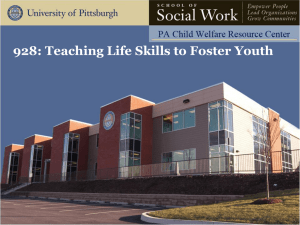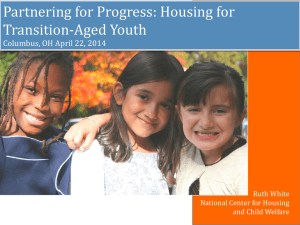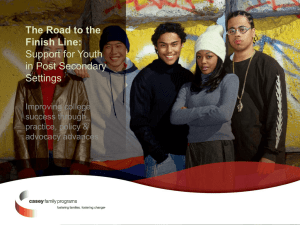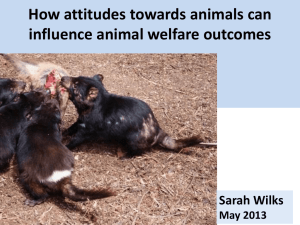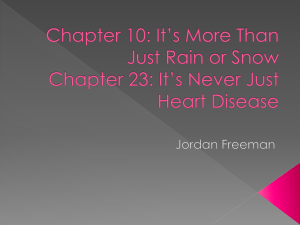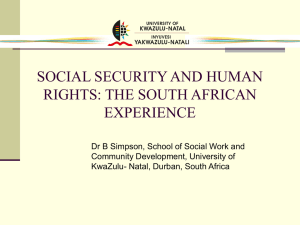Reconsidering Tribal Child Support Cost Recovery Practices, June 9
advertisement
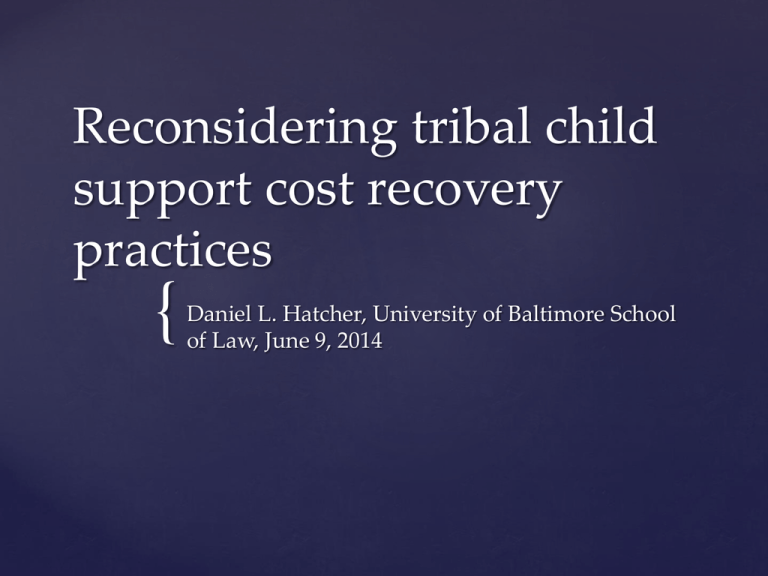
Reconsidering tribal child
support cost recovery
practices
{
Daniel L. Hatcher, University of Baltimore School
of Law, June 9, 2014
Understand how harm results from cost
recovery using child support
Understand the intensity of the harm – and that
more harm to tribes than states because of
higher relative poverty numbers.
Understand that while tribes face more harm,
tribes also have more discretion and can take
the lead in doing what’s right for children and
families
Understand that doing what’s right for children
and families can also make the lives of tribal
child support directors easier - because fewer
unmanageable cases
Some goals….
How human service agencies and their parent
states are using vulnerable populations as a
revenue source
Conflict between agency and state fiscal selfinterest and the best interests of those served
Focus of research…
Partnership between private industry and
government, using vulnerable populations as a
source of government revenue and private
profit
Medicaid maximization
Foster children’s Social Security benefits
Nursing homes
DSH Hospitals
Child Support
School based medicaid
Prescription Drugs
MAXIMUS example
Foster Child As Source of Revenue (new slide)
The Poverty Industry
{
In 2002, Alabama “spent” $272 million on child
welfare. There were about 5,800 children in
foster care in Alabama in 2002.
Divide that out = about $47,000 per child.
Subtract out IV-B and its $45,000
45,000 = $3,750 PER MONTH per child
The amount Alabama paid its foster care
providers to care for children in 2002? Between
$350-380 per month.
Example foster care
numbers to consider…
Starting at the end – recommendations
Primary Recommendation: Use discretion to
benefit children and families
Turning to cost recovery
through child support
WELFARE
Expansive “good cause” to not require child
support cooperation and assignment. Value
choice of the custodial parent. Best interests of
child should always control.
Expansive use of ground to deviate downward
from child support guidelines when support is
owed to gov’t.
Pass through child support to families.
Exercise discretion to reduce driver’s license
suspensions and credit reporting.
Focused
recommendations
WELFARE
Arrears Management.
Declare best interests of child as paramount. And
mean it.
Forgive state owed arrearages.
Debt leveraging option.
Automatically suspend child support for
incarcerated obligors.
Sounds obvious – but sometimes the most obvious
is the easiest to overlook.
Make the connections and take off the blinders.
Welfare, Foster Care, Child Support, Housing,
Criminal Justice, Juvenile Justice, Education
Dept, Health care, Mental health, Courts.
Recommendations
continued…
FOSTER CARE
Most of the same recommendations as with
welfare cost recovery, plus….
Expansive use of “where appropriate” language.
Don’t refer cases to child support if contrary to
best interests of child or conflicting with
reunification efforts.
Don’t include child support as part of reunification
plan.
Don’t take children’s Social Security benefits, but
rather use the funds to help the children and
families.
Understand that short term revenue can cause
long term costs.
Recommendations
continued
Out of the $107 billion in child support debt
nationwide, the government claims half so it
can seek to recoup the costs of public assistance
provided to low-income families.
Cost Recovery requirements – child support
cooperation and assignment
Public Assistance and
Child Support
When child support provided to children and
families, can be tremendous help
But the side of child support that forces the
child support obligation and takes payments
from children and families causes harm
Benefit or Harm
For children whose child support has been assigned to the
government, the reality of child support is harmful
Poor mothers are forced to name absent fathers, and then sue
them—and sue them again and again.
Because the fathers are often also poor, the vast amount of assigned
child support goes unpaid and insurmountable arrearages quickly
result.
Fathers who try almost always fail as the automated enforcement
mechanisms take over: a trucker’s license is suspended, so he cannot
work; a laborer’s wages are garnished at sixty-five percent, so he cannot
afford to pay his own rent; a father obtains a new job and then loses it
after being incarcerated for contempt because of his child support
arrearages.
The relationships between the mothers and fathers, fragile at their
beginnings, can be obliterated through the process. The hopes of
children to have fathers who are supportive and involved in their
lives can be dissolved.
Harm…
Little if any gain to counter the loss because welfare cost
recovery is a fiscal failure. Financial benefit to the
government from welfare cost recovery is minimal and
may actually be negative.
Small percentage of assigned support that is successfully
collected is diverted from the children and their families
when they most need it, decreasing their economic
stability and increasing their likelihood of needing
welfare again in the future.
Also reduced in-kind support
Harm continued…
Child support cost recovery also results in legal
conflict.
Reimbursing welfare costs directly conflicts with
serving the best interests of the children, long
recognized as the paramount purpose of child
support. The two goals simply cannot coexist.
Every dollar taken from a child in the name of
welfare cost recovery is a dollar that does not serve
the best interests of the child. Yet, despite the
conflict, child support agencies attempt to serve
both purposes simultaneously.
Harm continued
State vs. state. State’s own interests are aligned against
each other. Looking forward, states have an interest in
supporting the future welfare and best interests of
children and an interest in reducing the likelihood that
single- parent households will need future public
assistance. Looking back, once a family has received
welfare assistance, states have a short- term interest in
seeking reimbursement of the public costs of the
welfare assistance already provided. The interests are in
direct conflict.
Culture of conflict – state vs
state vs mom vs dad vs child
State vs. parents and child
Mom vs. Dad
Cost recovery pits family members against each other.
At the time of the birth of a new child, young unmarried
parents in “fragile families” have the potential for a healthy
relationship. Most of the mothers want the fathers to have
significant involvement in their children’s lives and the
fathers want to do right by their children. The fragile
families have hope. But rather than building on that hope
with supportive services aimed at encouraging healthy
relationships, welfare cost recovery adds turmoil.
Culture of conflict…
Parents vs. children
Fathers can be further alienated from their children as
they are unable to make payments and thus may
reduce visitations out of embarrassment or simply the
desire to hide from enforcement efforts.
Even the relationship of mother and child can become
adversarial. Most children hope for a relationship with
their absent parents. Unable to understand the forced
system, the children are witness to their mothers suing
their fathers in court and may blame one or both
parents when their fathers retreat further from family
contact.
Culture of conflict..
Government child support officials recognize the
failings of welfare cost recovery, and they describe a
shift in priorities. No longer is cost recoupment the
primary aim of child support offices.
But although signs of the changing mission are
evident, the shift is far from complete. States not on
board yet…
Deficit Reduction Act of 2005 – pass through and
disregard. Other discretion available. States not taking
advantage of discretion.
In anti-tax fiscal climate, the pressure on states to pursue
long- standing revenue streams is powerful.
Moving forward…
Pass through and disregard
Good cause for noncooperation
Realistic guidelines
Downward deviations from guidelines when in
best interests of children
Available discretion…
Foster care cost recovery through child support
enforcement initiated under the requirements of Title IVE of the Social Security Act.
To receive the federal funds, IV-E requires inter- agency
partnership in effort repay foster care costs. Child
support obligations initiated against mothers and fathers
of foster children, and rather than using the payments for
the children’s benefit, the child support is assigned to the
government.
Only applies to children removed from poor families.
Foster Care and Child
Support
Children in foster care are not likely to come from rich
families. Children in families with annual incomes below
$15,000 twenty-two times more likely to experience some
form of maltreatment than children whose families earned
$30,000 or more per year. This poverty correlation doubles
when considering only child neglect, and neglect is the most
common type of maltreatment.
The parents of foster children present harsh portrayals of the
causes and effects of poverty: former welfare recipients
fighting a losing battle for economic stability; victims of
domestic violence; young parents who grew up in foster care
repeating the cycle; parents struggling with substance abuse;
homeless mothers unable to find shelter, and families lacking
access to health care.
Poverty Correlation
Connection between poverty and foster care
exacerbated by state and federal policies and by the
overall funding structure of the child welfare system.
Reasonable efforts required to prevent the necessity of
child removal. But unfortunately, the “reasonable
efforts” to provide needed services are usually
inadequate.
Title IV-B federal funding, available to provide services
to help struggling families stay intact, is capped. In
contrast, Title IV-E funding provided to assist states
with foster care costs after child removal is structured
as an entitlement, and thus limited only by the number
of eligible children.
Poverty correlation cont…
Title IV-E payments are targeted so that states have a
financial preference to remove foster children from poor
families.
Private consultants often hired to develop strategies to
increase the “penetration rate”—the percentage of foster
children from poor families. Children in low- income
families, already at greatly increased risk of being assessed
for child maltreatment due to the circumstances of poverty,
are further targeted because they are viewed as coming
with money attached.
Combined with ASFA strict time limits. And unpaid
support used as grounds for TPR.
Poverty correlation cont…
The effort to recover foster care costs through child
support enforcement diverts the child welfare
agencies’ missions. The over- arching purpose of the
child welfare system is to protect the welfare of
children while simultaneously striving to strengthen
and preserve families. The child support program is
guided by the best interests of the child standard.
However, through the forced intersection of the two
programs in order to recover costs, a shift occurs that
subverts the agencies’ core missions to the cost
recovery pursuit – and harm results.
Harm and diverted
mission…
Places gov’t fiscal interests over best interests of
children
Hurts reunification efforts
Can extend stays in foster care
Hurts families after reunification
Alienates parents
Individual caseworkers often oppose the policy
Little if any fiscal benefit to gov’t
Harm…
Diversion of statutorily required mission
Misuse of required case plans – using children
as collateral
Termination of parental rights for gov’t debt
(substantive due process)
North Carolina Example
Illegality of practices
42 U.S.C. § 671(a)(17). “[W]here appropriate, all steps will
be taken, including cooperative efforts with the State
agencies administering the program funded under part A of
this subchapter and plan approved under part D of this
subchapter, to secure an assignment to the State of any
rights to support on behalf of each child receiving foster
care maintenance payments under this part.”
“Where appropriate” provides a lot of discretion to not
refer cases, but states often ignore discretion.
Discretion ignored
WELFARE
Expansive “good cause” to not require child
support cooperation and assignment. Value
choice of the custodial parent. Best interests of
child should always control.
Expansive use of ground to deviate downward
from child support guidelines when support is
owed to gov’t.
Pass through child support to families.
Exercise discretion to reduce driver’s license
suspensions and credit reporting.
Focused
recommendations
WELFARE
Arrears Management.
Declare best interests of child as paramount. And
mean it.
Forgive state owed arrearages.
Debt leveraging option.
Automatically suspend child support for
incarcerated obligors.
Sounds obvious – but sometimes the most obvious
is the easiest to overlook.
Make the connections and take off the blinders.
Welfare, Foster Care, Child Support, Housing,
Criminal Justice, Juvenile Justice, Education
Dept, Health care, Mental health, Courts.
Recommendations
continued…
FOSTER CARE
Most of the same recommendations as with
welfare cost recovery, plus….
Expansive use of “where appropriate” language.
Don’t refer cases to child support if contrary to
best interests of child or conflicting with
reunification efforts.
Don’t include child support as part of reunification
plan.
Don’t take children’s Social Security benefits, but
rather use the funds to help the children and
families.
Understand that short term revenue can cause
long term costs.
Recommendations
continued
Use discretion available, and work to serve the
bests interests of children and families.
Don’t lose sight of what this is all about.
Concluding thoughts

